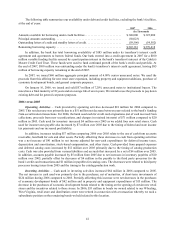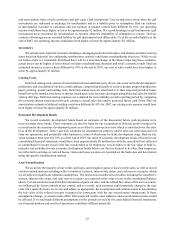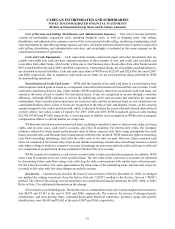Cabela's 2007 Annual Report Download - page 53
Download and view the complete annual report
Please find page 53 of the 2007 Cabela's annual report below. You can navigate through the pages in the report by either clicking on the pages listed below, or by using the keyword search tool below to find specific information within the annual report.47
and expectations. Sales of gift certificates and gift cards (“gift instruments”) are recorded in revenue when the gift
instruments are redeemed in exchange for merchandise and as a liability prior to redemption. Had our estimate
of merchandise in-transit to customers and our estimate of product returns been different by 10%, our operating
income would have been higher or lower by approximately $2 million. We record breakage on gift instruments (gift
instruments never presented for merchandise) as revenue when the probability of redemption is remote. Had our
estimate of breakage on our recorded liability for gift instruments been different by 1% of the recorded liability at the
end of 2007, our operating income would have been higher or lower by approximately $11 million.
Inventories
We estimate provisions for inventory shrinkage, damaged goods returned values, and obsolete and slow-moving
items based on historical loss and product performance statistics and future merchandising objectives. While we do
not believe there is a reasonable likelihood there will be a material change in the future impacting these estimates,
actual losses can be higher or lower based on future merchandising decisions and retail economic trends. Had our
estimated inventory reserves been different by 10% at the end of 2007, our cost of sales would have been higher or
lower by approximately $1 million.
Catalog Costs
Deferred catalog costs consist of incremental internal and third-party direct costs incurred in the development,
production, and circulation of our direct mail catalogs, composed principally of creative design, prepress/production,
paper, printing, postal, and mailing costs. Deferred catalog costs are amortized over their expected period of future
benefit or twelve months, whichever is shorter, based upon sales forecasts developed using historical sales for similar
catalog offerings. Deferred catalog expenses are evaluated for recoverability at each reporting period by comparing
the carrying amount associated with each catalog to actual sales data and to projected future cash flows. Had our
amortization estimate of deferred catalog costs been different by 10% for 2007, our catalog costs expense would have
been higher or lower by approximately $3 million.
Economic Development Bonds
We record economic development bonds based on estimates of the discounted future cash payments to be
received under these bonds. These estimates are also the basis for our recognition of deferred grant revenue to be
received under the economic development grants as an offset to construction costs which is amortized over the asset
lives of the development. These cash flow estimates are dependent on property and/or sales tax collections derived
from our operations, and potentially other businesses, some of which may be in the development stage. Had our fair
value estimates been lower by 10% as of the end of 2007, the value of economic development bonds reflected in our
consolidated financial statements would have been approximately $9 million less with the unrealized loss reflected
in comprehensive income (loss) if the loss was deemed to be temporary. Any declines in the fair value of held-to-
maturity and available-for-sale economic development bonds below cost that are deemed to be other than temporary
are reflected in earnings as realized losses. Gains and losses on sales are recorded on the trade date and determined
using the specific identification method.
Asset Securitization
We securitize the majority of our credit card loans, and recognize gains or losses on the sales, as well as record
certain retained interests including seller’s transferor’s interest, interest only strips, and cash reserve accounts, which
are all subject to significant valuation assumptions. The interests in securitized receivables, including the transferor’s
interest, interest only strips, and cash reserve accounts, are reported at fair value or cost in the consolidated balance
sheets. Certain estimates used in the determinations of gains on sales, and the related fair values of the asset accounts,
are influenced by factors outside of our control, and as a result, such estimates could materially change in the near
term. On a quarterly basis, we review and adjust, as appropriate, the assumptions and estimates used in determining
the fair value of the related accounts recognized in connection with the our securitization transactions. If these
assumptions change, or actual results differ from projected results, asset balances and securitization income would
be affected. If we had made different assumptions for the periods covered by the consolidated financial statements,
our financial position and results of operations could have differed materially.
























